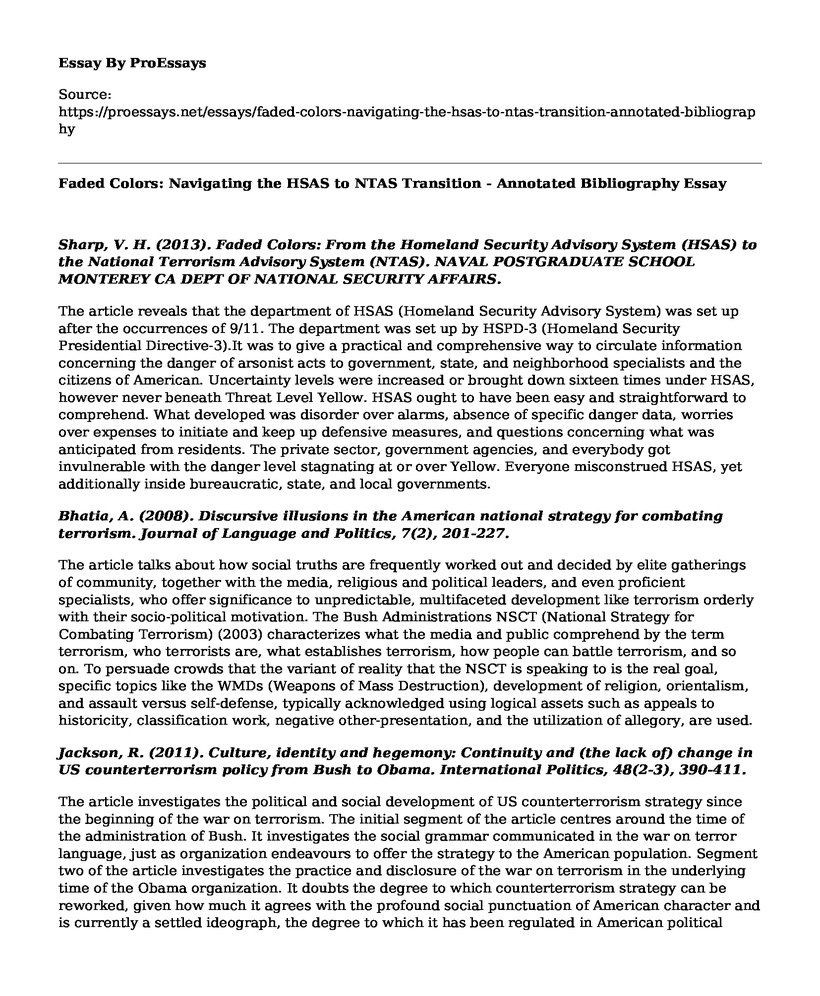Sharp, V. H. (2013). Faded Colors: From the Homeland Security Advisory System (HSAS) to the National Terrorism Advisory System (NTAS). NAVAL POSTGRADUATE SCHOOL MONTEREY CA DEPT OF NATIONAL SECURITY AFFAIRS.
The article reveals that the department of HSAS (Homeland Security Advisory System) was set up after the occurrences of 9/11. The department was set up by HSPD-3 (Homeland Security Presidential Directive-3).It was to give a practical and comprehensive way to circulate information concerning the danger of arsonist acts to government, state, and neighborhood specialists and the citizens of American. Uncertainty levels were increased or brought down sixteen times under HSAS, however never beneath Threat Level Yellow. HSAS ought to have been easy and straightforward to comprehend. What developed was disorder over alarms, absence of specific danger data, worries over expenses to initiate and keep up defensive measures, and questions concerning what was anticipated from residents. The private sector, government agencies, and everybody got invulnerable with the danger level stagnating at or over Yellow. Everyone misconstrued HSAS, yet additionally inside bureaucratic, state, and local governments.
Bhatia, A. (2008). Discursive illusions in the American national strategy for combating terrorism. Journal of Language and Politics, 7(2), 201-227.
The article talks about how social truths are frequently worked out and decided by elite gatherings of community, together with the media, religious and political leaders, and even proficient specialists, who offer significance to unpredictable, multifaceted development like terrorism orderly with their socio-political motivation. The Bush Administrations NSCT (National Strategy for Combating Terrorism) (2003) characterizes what the media and public comprehend by the term terrorism, who terrorists are, what establishes terrorism, how people can battle terrorism, and so on. To persuade crowds that the variant of reality that the NSCT is speaking to is the real goal, specific topics like the WMDs (Weapons of Mass Destruction), development of religion, orientalism, and assault versus self-defense, typically acknowledged using logical assets such as appeals to historicity, classification work, negative other-presentation, and the utilization of allegory, are used.
Jackson, R. (2011). Culture, identity and hegemony: Continuity and (the lack of) change in US counterterrorism policy from Bush to Obama. International Politics, 48(2-3), 390-411.
The article investigates the political and social development of US counterterrorism strategy since the beginning of the war on terrorism. The initial segment of the article centres around the time of the administration of Bush. It investigates the social grammar communicated in the war on terror language, just as organization endeavours to offer the strategy to the American population. Segment two of the article investigates the practice and disclosure of the war on terrorism in the underlying time of the Obama organization. It doubts the degree to which counterterrorism strategy can be reworked, given how much it agrees with the profound social punctuation of American character and is currently a settled ideograph, the degree to which it has been regulated in American political practice. Finally, the article ponders inquiries of progress and character in the development of US international strategy.
Perl, R. F. (2007, November). National Strategy for Combating Terrorism: Background and Issues for Congress. LIBRARY OF CONGRESS WASHINGTON DC CONGRESSIONAL RESEARCH SERVICE.
The article talks about how the White House discharged the 2006 National Strategy for Combating Terrorism on September 5, 2006. The report analyzes the Strategy concerning its antecedent, released in 2003, and distinguishes issues and choices for thought by Congress. The National Strategy for Combating Terrorism of 2006 gives a system for securing the United States and its partners from terrorist assaults. The main parts of the Strategy are to disable and disturb terrorist operations over the globe and encourage worldwide participation in these endeavors. The article also adds that it is through creating worldwide bigotry of terrorism is focal too.
References
Bhatia, A. (2008). Discursive illusions in the American national strategy for combating terrorism. Journal of Language and Politics, 7(2), 201-227.
Jackson, R. (2011). Culture, identity and hegemony: Continuity and (the lack of) change in US counterterrorism policy from Bush to Obama. International Politics, 48(2-3), 390-411.
Perl, R. F. (2007, November). National Strategy for Combating Terrorism: Background and Issues for Congress. LIBRARY OF CONGRESS WASHINGTON DC CONGRESSIONAL RESEARCH SERVICE.
Sharp, V. H. (2013). Faded Colors: From the Homeland Security Advisory System (HSAS) to the National Terrorism Advisory System (NTAS). NAVAL POSTGRADUATE SCHOOL MONTEREY CA DEPT OF NATIONAL SECURITY AFFAIRS.
Cite this page
Faded Colors: Navigating the HSAS to NTAS Transition - Annotated Bibliography. (2023, Apr 24). Retrieved from https://proessays.net/essays/faded-colors-navigating-the-hsas-to-ntas-transition-annotated-bibliography
If you are the original author of this essay and no longer wish to have it published on the ProEssays website, please click below to request its removal:
- Fetal Alcohol Abuse Syndrome
- Essay Sample on Influence of Female Autonomy on the Indian Society
- Alcoholic Liver Disease: Case Study
- Schools: Building Cohesive Environments to Prevent Shootings - Essay Sample
- Essay on School Improvement: Drafting a Strategy for Better Outcomes
- Paper Example on Gender Inequality in Susan Glaspell's Play: Mrs. Peters & Mrs. Hale
- Paper Sample on A Witch and a Worker: Margaret & Andrew's Unexpected Love Story







